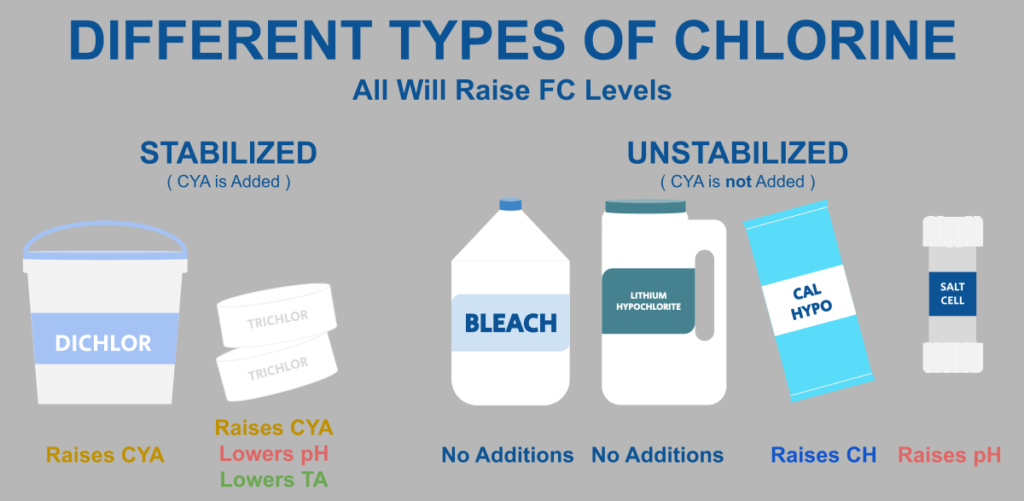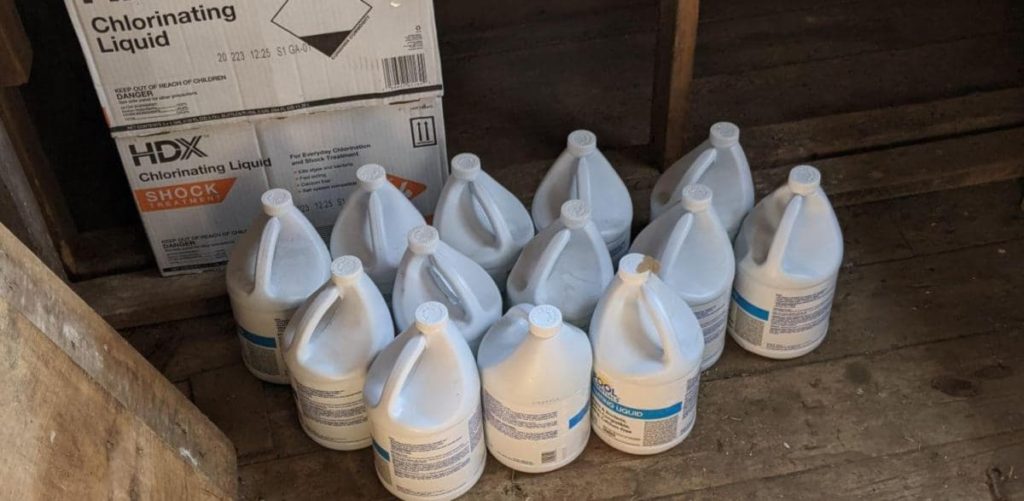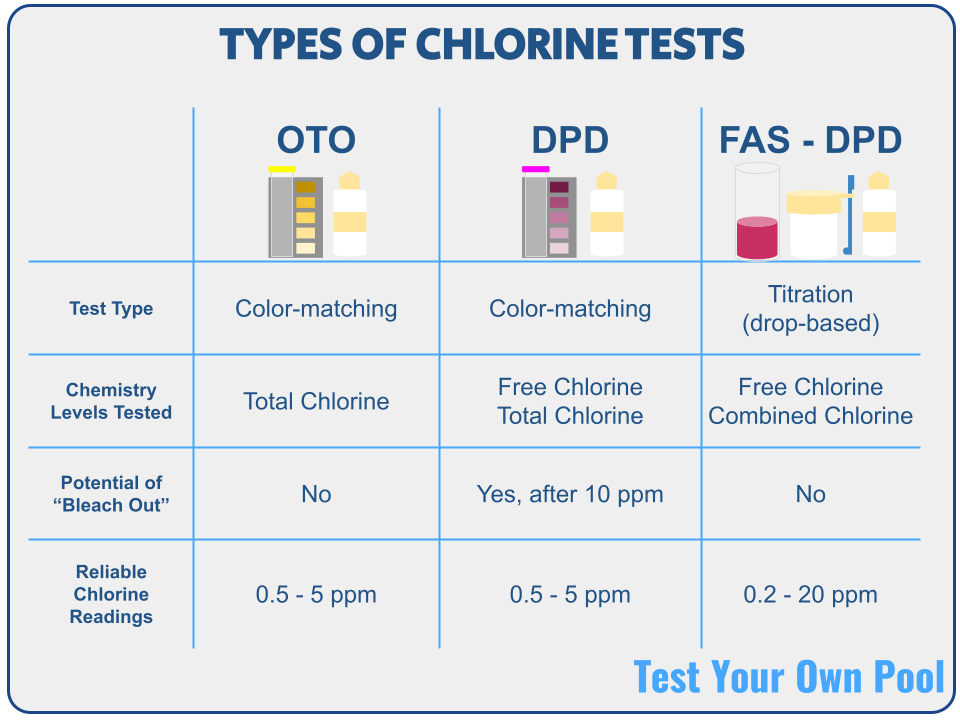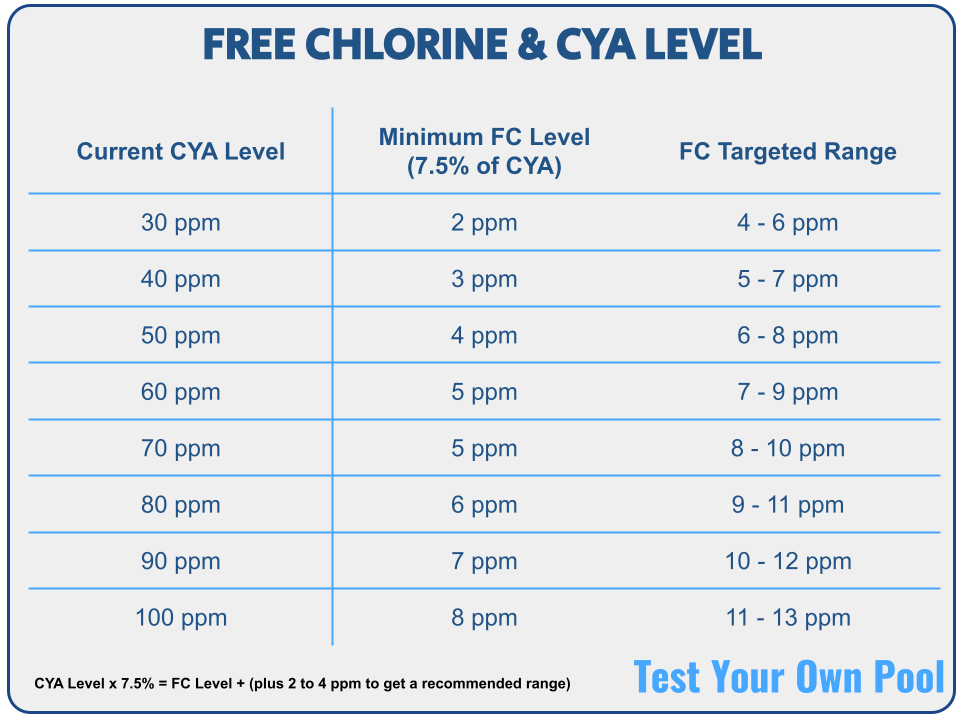Keeping the pool water balanced is the ultimate goal for any pool owner. And one of the biggest impacts of that balance is managing free chlorine (FC) levels.
You raise free chlorine “simply” by adding chlorine to the pool. Sometimes it isn’t that simple, however
You may have added chlorine, but FC levels remained the same or even dropped. You may ask, “Why is there no free chlorine in my pool?” or “Why is free chlorine low?“
These are common questions with a simple answer; chlorine is actively fighting organics, or there isn’t enough stabilizer to “protect” it from deteriorating. Let’s break that down.
What is Free Chlorine and its Role in Pool Chemistry?
Free chlorine (FC) refers to the level of sanitation in the water that fights and kills any germs, algae, or combined chlorine (chloramines) that may be present in the pool. It plays a pivotal role in neutralizing the “bad stuff” and ensuring the pool is safe for swimming.
It is simply the amount of chlorine that is “free” or available that hasn’t been used yet.
When free chlorine is low in pools, it can lead to water problems such as bacteria and algae growth. This makes the water unsafe to swim and can lead to murky water.
Free chlorine should always be present in the pool, with a minimum of 2 ppm at all times.
Why is Free Chlorine Low?
If you are noticing low free chlorine levels, several factors could be responsible:
Cyanuric Acid (CYA) Levels are Not Balanced
Cyanuric Acid (CYA) stabilizer protects chlorine from the sun’s UV rays. This helps chlorine last longer and be more effective in the pool.
CYA should be between 30 to 60 ppm to ensure there is proper protection of chlorine.
When CYA is low, free chlorine levels get broken down and used up quicker.
High CYA levels reduce the effectiveness of chlorine, making it much harder to keep the pool clear of bacteria and algae. Free chlorine levels are “low” based on the CYA level.
The type of chlorine that you use impacts the CYA level. Chlorine comes in stabilized or unstabilized forms.
- Stabilized chlorine has CYA added to its chemical makeup. Trichlor and dichlor are examples of stabilized forms of chlorine.
- Unstabilized chlorine does not include CYA. This includes liquid chlorine (bleach), calcium hypochlorite (cal-hypo), and lithium hypochlorite. Saltwater pools are also considered unstabilized.

Chlorine is Attacking Something in the Water
Chlorine gets used up by two things: UV rays (which is solved by the addition of CYA) and contaminants in the water.
If you eliminate low or high CYA as a problem, there is a good chance that the pool is fighting algae growth or other chloramines in the water.
This would typically require a heavier dose of chlorine to eliminate what it’s actively fighting. This process of adding more chlorine than normal is called shocking the pool.

You might read about the necessity to shock your pool every week to keep it balanced, but that isn’t true. Shocking should only be done if there is an active problem with your water. If chemistry levels are always balanced, there is no need to shock!
Constant Pool Use
What’s the point of having a pool if you don’t enjoy it? This isn’t about discouragement of swimming or having parties, to understand the effects of pool activities.
More people swimming and using the pool will invite more contaminants in the pool that chlorine will need to take care of. Sunscreen, oils from skim, dirt, and debris will accumulate when swimming, so more free chlorine will be used up.
Always test your pool before and after heavier use to balance all chemistry levels.
Introduction of “New” Water
If fresh water has been added to the pool by topping it off from the tap or heavy rains, it will dilute most of the chemistry levels, including free chlorine.
It’s always a good idea to test and add the necessary pool chemicals after adding fresh water.
Inaccurate Test Results
This one is easy: there are low free chlorine levels because not enough chlorine has been added to the pool.
Inaccurate and unreliable testing can cause wrong test results, resulting in wrong chemical additions. It is important to ensure you test the pool with a reliable testing kit.
How to Raise Free Chlorine Levels in the Pool
To raise free chlorine, we need to add chlorine to the pool! But before we do that, it’s important to know your pool’s current chemistry levels and the ideal free chlorine level. For that, we need to test!
Most test kits will be able to give you a variation of free chlorine, combined chlorine, or total chlorine levels. Total chlorine is simply the sum of free and combined chlorine levels:
TC = FC + CC
Depending on the type of chlorine test your kit uses will determine which parameter is being tested. The most accurate version of a chlorine test is FAS-DPD. It measures free chlorine and combined chlorine separately without the need to do any mental math. See the below chart for a comparison of the three different methods:

The best testing kit for a FAS-DPD chlorine test is the Taylor K-2006. It is by far the most accurate test out on the market.
The most accurate and reliable pool testing kit.
Type of Chlorine Test: FAS-DPD
Read our full Taylor K-2006 Review.
The amount of free chlorine that needs to be in the pool depends on your current CYA level. It’s recommended that 7.5% of CYA level needs to be FC in order to prevent algae growth.
Very smart people like Richard Falk determined that pools need at least 7.5% of the CYA level to be FC in order to fight algae growth. Using the following math equation, your free chlorine levels should be:
CYA Level x 7.5% = FC Level + (plus 2 to 4 ppm to get a recommended range)
Ideally, you should never fall below the minimum (nearest whole number).
Check your targeted free chlorine range using our handy calculator or refer to the guide below:
Free Chlorine & CYA Levels

Once it is determined what your FC level should be, use our chlorine calculator to know how much needs to be added depending on the kind of chlorine that is being used.
Maintain Proper Chlorine Levels
Maintaining chlorine levels is about knowing how to raise free chlorine in pools and consistency.
Free chlorine should be tested and adjusted daily to keep it balanced. As mentioned before, pay extra attention to the chemistry levels after heavy pool usage or after rains to ensure everything is balanced.
A couple of minutes a day might save you from headaches later!
Frequently Asked Questions
Why do I have no free chlorine in the pool after shocking?
If you recently shocked your pool and testing still shows low free chlorine, the water is fighting algae or other bacteria and requires even more chlorine.
How do I increase free chlorine in a saltwater pool?
For saltwater pool owners, increasing free chlorine can be done by turning up the dial on your saltwater cell or manually adding more chlorine to the water. If you need to shock your saltwater pool, use unstabilized chlorine like liquid chlorine or cal-hypo.
Is it safe to swim in a pool with low free chlorine?
If your pool has no free chlorine, it runs the risk of growing algae or other harmful bacteria, which is unsafe to swim in. Safe free chlorine levels will depend on CYA. If your FC readings are within the recommended range based on CYA levels, then it is OK to swim in. Anything lower than the minimum can be an invitation for algae growth.

